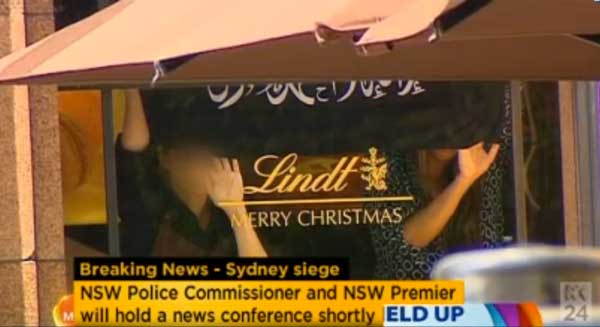While we await an internal police review and coroner’s inquiry into the siege of the Lindt Café by gunman Man Haron Monis last month evidence has been seeping into the press and questions are being raised about police tactics and what happened. Earlier media reports are reflected in the Wikipedia entry:
It was reported that hostage Tori Johnson’s attempt to wrest the gun from Monis may have triggered the police response.[41] However, a survivor told his family that the shot that prompted the police response was a warning shot fired when the hostages kicked down a door in an attempt to escape. Video evidence appears to show that Johnson was shot by Monis after police stormed the café. Police said they would not be commenting until the investigation was over.[42]
Hostage Katrina Dawson was killed by a police bullet, probably a ricochet,[43][40] although initially a police spokesman reported that she died of a heart attack on the way to hospital.[44]
Last Saturday Nick Ralston in the SMH advised that “multiple police sources have told Fairfax Media that Ms Dawson, 38, was struck by police fire that was not a direct shot and possibly a ricochet, when they stormed the cafe…” (emphasis added).
On Monday Rick Feneley reported that there was division over police tactics.
Early in the piece police devised a direct action plan to storm the building and take Monis by surprise. The suggestion is that this was countermanded, with such action to be reactive only.
Despite the risks, the advantage of a direct action plan is that police seize control and decide the time rather than react in split seconds to the gunman’s action.
Fairfax Media has learned there is some anger among police at the front line of the siege about the decision not to proceed with the direct action plan.
Also:
Police rejected the offers of many in the Muslim community to help them negotiate with the gunman. It is understood they would be loath to allow third parties, with no experience in hostage negotiations, to talk to a gunman – because they may be unable to control what they say or how the hostage taker might react.
Among those to offer their services were the Grand Mufti of Australia, Dr Ibrahim Abu Mohammad, but he was not called in – neither to help negotiate nor to advise police.
Feneley further reports that the police had little or no contact with Monis – “in fact we’re not dealing directly with him” and “At this stage we do not have direct contact with the offender.”
Guy Rundle at Crikey takes up these and other issues.
Rundle is concerned that the apparent lack of effort to communicate with Monis may have stemmed from his self-proclaimed status as an IS representative. Police may have taken a “we don’t negotiate with terrorists” attitude, in effect militarising the situation.
Were any professional hostage negotiators even summoned? How many of these do Australian police forces have, and how good is their training? Are there clear protocols for hostage situations in place and do they categorise purportedly political events differently to “civil” situations? Do they differentiate between rational, purposeful violent political acts, and disorganised and confused political or pseudo-political acts and actors?
Why were the offers from Muslim community leaders to speak to Monis rejected, when it is a common practice to use in that way figures whom a hostage-taker might respect? Did police distrust the bona fides of Australian Muslims, believing their loyalties would be to Muslims, including Monis, rather than to the wider community?
Rundle also asks whether there was any political interference in the operation, formal or informal.
Finally:
Political opportunists tried to enrol Johnson as a “hero” who had tried to grab Monis’ gun, and died for it. He may simply have been executed — and that may have occurred because of compromised or incompetent police procedure. That Dawson died laying her body over that of a pregnant fellow hostage appears established. That she died from a police bullet does not alter that. But if it resulted from needlessly compromised procedure, then the police are partly culpable for a needless death. To turn anyone killed into a “hero” is a denial of the possibility of victimhood, of innocence, and thus of unconditional worth of any human being. To do so on the basis of clearly false information is an act of disdain. To use it as a means by which future such crises will be shaped and distorted, is actively evil. The unscrupulous love to wrap themselves in a flag whatever the event. They’re happy to use it as a shroud for any number of us, if that’s what it takes.
As you can see Rundle really bores in, but he is demanding that the facts be established by meticulous examination of the details of the last minutes before wider meaning is assigned to events.
Our earlier post on the siege is here.

